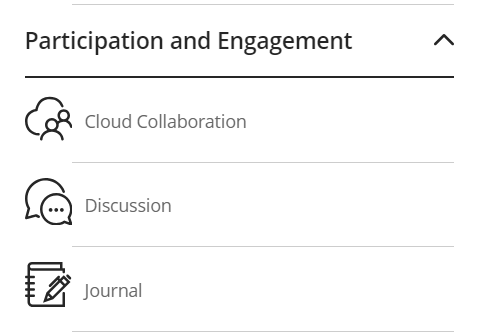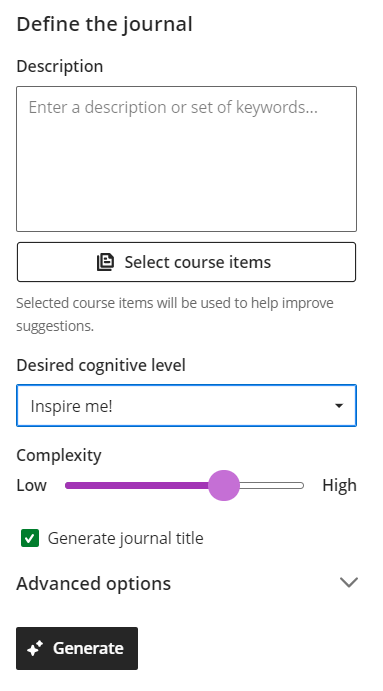Introduction
Journals in Blackboard can be used for a variety of reasons: to help aid student reflection, develop deeper insights, share research topics and so on. By using the Design Assistant tool, you can create journal prompts effortlessly. The Design Assistant tool will analyse existing content in the module, using this material as a basis to generate journal ideas. For example, you can “point” the tool at multiple Microsoft Word documents and it will analyse these documents in order to create journal prompts, rapidly speeding up the creation process.
Video Tutorial
Create A New Journal
- Navigate to the space in the Module Content area where you want to create your journal, hover your mouse over the desired location and click the plus icon
- From the drop down menu, select Create

- From the right hand side menu, scroll down and select Journal underneath Participation and Engagement

- You will be presented with the Journal canvas.

- You can give your journal a meaningful title in the top left of the screen, but there is an option to let the tool auto-generate a title for you (see below).
Autogenerate Journals
There are several ways in which you can leverage the power of the Design Assistant tool. Start by clicking the option to Auto-Generate Journal, located in the top right hand of the screen.
If your journal is within a space that has content (for example, within a specific Learning Module), it will attempt to scan the material found within to provide you with some suggested journal ideas. As with everything created via AI, it is essential for you to review the prompts to accuracy and bias.
If the suggested items don’t fit your needs, try some of the following options to Define the journal.

- Supply some more in-depth text in the Description box. You can type up to 2000 characters here, and this will ensure the tool will focus on your specific needs.
- By clicking on Select Course Items, you can point the tool to interrogate existing course items within the module. This can be Ms Word documents, Ms PowerPoints, Adobe PDFs as well as Blackboard Documents. You can choose multiple items and spaces in your module. When you have selected all the appropriate items, click on Select Items to continue.
- Adjust the Desired Cognitive Level as appropriate. As mentioned in the Introduction, these are based on Bloom’s Taxonomy and provide you with the opportunity to create more tailored journal prompt. Experiment with the different levels, or even try the “Inspire me!” to get a varied mix of prompts. If you use the “Inspire me!” option, the system will inform you which cognitive level each prompt belongs to.
- Adjust the Complexity as required. These vary from Low (based on Primary school level) to High (based on higher level degrees)
- By default, the Generate journal title is automatically checked. Leave this as it is if you want the Design Assistant tool to create a title for you, but this can always be edited later on.
- Under Advanced options, there is the ability to change the Output language.
- Click Generate
The Design Assistant will generate three Journal Prompts at a time. Based on the results, you might need to adjust the options again and click on Generate to get better results. When satisfied, click the radial button next to the Journal prompt you want to use, and click Add in the bottom right hand corner of the screen.
Adjustments
Once you’ve selected a journal prompt and clicked Add, you will be taken back to the Journal tool canvas. It is essential that you thoroughly check the journal prompt for accuracy and bias. To this end, you can edit both the title and the journal prompt as appropriate. If required, you can add additional commentary to the journal prompt, as well as including images and specific formatting.
If you require the Journal to be marked, open the Journal Settings by clicking the cog icon over to the right of the page or click on the text that says “Journal isn’t marked”. From the side panel that appears, you can select the “Grade Journal” option.
Click on Save.
